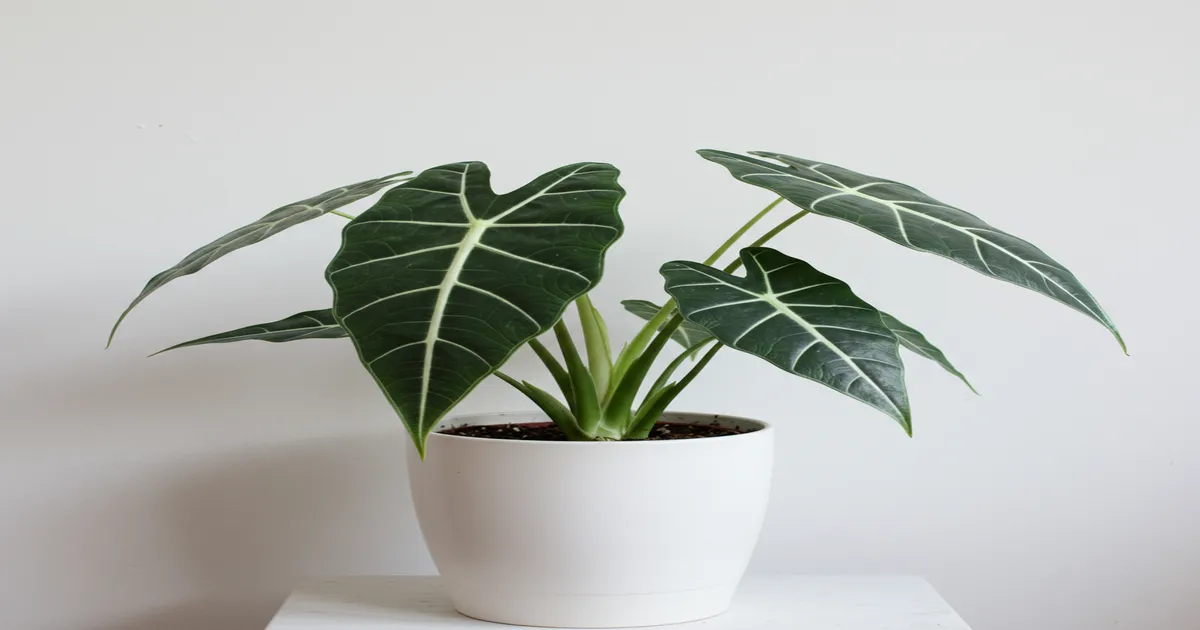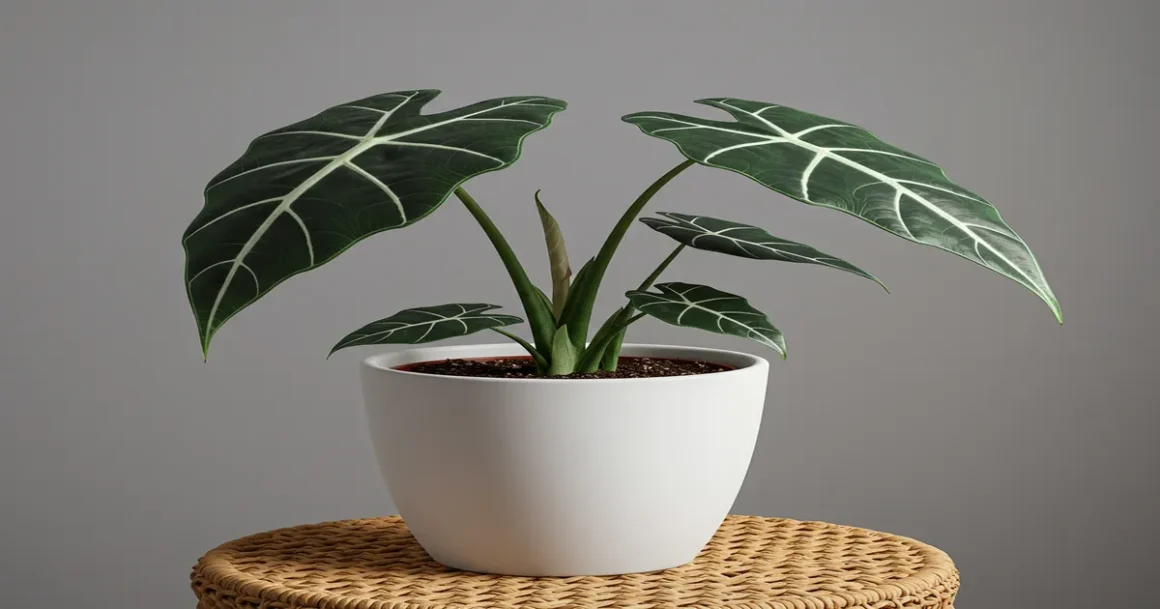Alocasia zebrina, known as the zebra plant, is a tropical indoor plant highly valued for its stems resembling zebra stripes. It can be challenging to acquire and cultivate due to its specific growth requirements. The plant features large, heart-shaped leaves that sprout from the white-and-green striped stems. Originating from the Philippine rainforests, this plant demands similar conditions such as moist, fertile, well-drained soil, filtered sunlight, warm climate, and high humidity levels. While it grows rapidly, it only produces flowers under ideal circumstances, typically concealed by the large leaves.
Alocasia is harmful to humans and pets.
| Common Name | Zebra plant, zebrina alocasia, tiger taro |
| Botanical Name | Alocasia zebrina |
| Family | Araceae |
| Plant Type | Perennial, bulb |
| Mature Size | 3 ft. tall, 3 ft. wide |
| Sun Exposure | Partial |
| Soil Type | Moist but well-draining |
| Soil pH | Acidic, neutral |
| Bloom Time | Spring, summer |
| Flower Color | Green, white |
| Hardiness Zones | 10-11 (USDA) |
| Native Area | Asia |
| Toxicity | Toxic to humans and pets |
Taking Care of Alocasia Zebrina

While it may seem challenging to ensure the well-being of this indoor plant, it can flourish in most households if provided with the right conditions. The key is to understand its natural growth environment and try to replicate those conditions. Here are the primary care guidelines for cultivating Alocasia zebrina:
- Offer filtered light.
- Maintain soil moisture without overwatering; the pot should have sufficient drainage holes.
- Ensure it is situated in warm temperatures with consistent humidity.
- Apply fertilizer monthly in the spring and summer.
Regularly cleaning the leaves of your Alocasia zebrina every one or two weeks can prevent dust buildup and promote photosynthesis, leading to more robust growth.
Light
This tropical plant thrives with several hours of bright, indirect sunlight. For north- or east-facing windows, place your zebrina directly in front to maximize light exposure. If you have a west- or south-facing window, position the plant a few feet away to avoid direct sunlight. Alternatively, use a sheer curtain or window film to filter direct light. Alocasia is sensitive to leaf scorching from excessive light but may drop leaves in low-light settings.
Soil
When selecting soil, remember that alocasias need ample nutrients to thrive and are susceptible to root rot from waterlogged conditions. Thus, the soil mix should be nutrient-rich and well-draining. An ideal mix includes equal parts potting soil, perlite or pumice, and coco peat.
Water
While the plant should not remain in soggy soil, it also dislikes completely drying out. It’s best to keep the soil consistently moist. Allow the top inch of soil to slightly dry between waterings, then water thoroughly, ensuring excess water drains from the pot.
Temperature and Humidity
Alocasia zebrina cannot tolerate temperatures below 65 degrees
Varieties of Alocasia Zebrina

With around 90 species in the Alocasia genus, these plants are mainly recognized for their large or distinctively veined leaves. Alocasia zebrina stands out for its uniquely striped stems and typically grows up to about 3 feet tall. While all alocasia plants can produce flowers, most of them are ordinary, and they seldom bloom when grown indoors.
Originating from the Philippines, A. zebrina is becoming increasingly rare in the wild due to excessive harvesting, but it continues to be grown through propagation techniques. Other alocasia varieties with distinct stem coloring include:
- Alocasia zebrina ‘Reticulata’: A cultivated form of A. zebrina; showcases a unique zebra-like pattern on its stems but features an interlacing or web-like design on its leaves
- Alocasia macrorrhizos ‘Stingray’: A different species; displays stems with patterns reminiscent of A. zebrina; its leaves resemble the shape of a stingray
- Alocasia macrorrhizos ‘Black Stem’: Another species of alocasia; known for its distinctively black stem and large taro-like leaves
Trimming

Trimming this plant is unnecessary except for getting rid of any damaged, dying, or dead leaves. Utilize sterilized pruning shears or snips to trim the affected stem at its bottom, and remember to wear gloves as this plant is poisonous.
How to Propagate Alocasia Zebrina
Alocasia can be easily propagated through division or by growing its corms, which are its underground root structures. Both methods are most successful when the plant is mature and healthy, and it is recommended to do this during regular repotting.
To propagate by division, you can follow these steps:
To propagate by growing corms, you can follow these steps:
Guide on How to Cultivate Alocasia Zebrina Using Seeds
While Alocasia zebrina is commonly propagated through division, it is also feasible to propagate it from seeds.
Guide for Potting and Repotting Alocasia Zebrina
Alocasia zebrina thrives when its roots are confined in a smaller pot, so frequent repotting is not necessary. However, when the current pot becomes too crowded or roots start escaping through drainage holes, it’s time to repot your Alocasia zebrina into a slightly larger pot. Since repotting can stress the plant, make sure to water it well a day or two before the process.
To repot, carefully remove the plant from its current container, inspect the roots, and consider dividing the plant if you notice root circling or multiple root systems. When dividing, gently untangle the roots, keeping them as intact as possible. If you are not dividing the plant, maintain the root ball’s integrity by shaking off only the excess old soil. Fill the new pot with a layer of fresh potting mix, position the root ball in the center, and fill in the remaining space, leaving about an inch from the top of the pot.
Common Insects and Plant Ailments
Be vigilant for spider mites, fungus gnats, and mealybugs, as they thrive in the damp environments that favor the growth of Alocasia zebrina. This plant is also prone to root rot, often caused by incorrect watering practices and poor soil drainage. Symptoms of root rot include yellow leaves, leaf loss, and soft, brown stems.
Common Issues with Alocasia Zebrina
Here are some typical problems you may face with this tropical plant:
Yellowing Leaves
Yellowing leaves are often a result of root rot caused by overwatering, underwatering, insufficient humidity, or inadequate light. To address this, evaluate your plant’s growing conditions to identify the reason for the yellow leaves.
Curled Leaves
Curling leaves typically indicate that your Alocasia zebrina lacks moisture or humidity. Make sure you maintain adequate moisture levels between waterings and keep the plant away from drafty windows or air vents that can dry out the air.
Leaf Drop
Dropping leaves suggest that something is amiss in your plant’s environment. Inadequate light, overwatering, underwatering, low humidity, and root rot are all potential reasons for leaf drop.
Drooping or Stem Bending
Droopy stems may indicate that the plant is holding too much water. To remedy this, allow the soil to almost dry out completely (about 2/3 of the pot). Also, check the drainage holes to ensure proper soil drainage. Sometimes, drooping or bending stems signal the opposite issue: lack of water, nutrients, or light. If a stem appears damaged from excessive bending, wrap it with florist tape to provide support and aid in healing.
FAQ
Is Alocasia zebrina a fast grower?
Under optimal conditions, it is considered a fast-growing plant, producing a new leaf every week or two during active growth.
Why is my Alocasia zebrina not growing?
If your plant shows no growth

